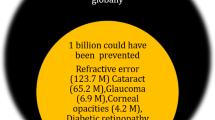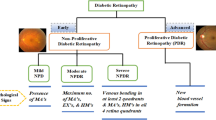Abstract
Imaging of the retinal complications of diabetes mellitus is rapidly changing from the emergence of new technology such as optical coherence tomography. In particular, the characterization of diabetic macular edema is much easier for the clinician and there are new, more sensitive clinical research end points. However, our understanding of structure-functional relationships remains suboptimal and the classification of macular edema by optical coherence tomography continues to evolve. The classification of diabetic retinopathy severity continues to rely upon fundus photography, although the transition from film to digital photography presents both challenges and advantages.



Similar content being viewed by others
References
Papers of particular interest, published recently, have been highlighted as: • Of importance
Diabetic Retinopathy Study Research Group. Report 7. A modification of the Airlie House classification of Diabetic Retinopathy. Investig Ophthalmol Vis Sci. 1981;21:210–26.
Early Treatment Diabetic Retinopathy Study Research Group. Grading diabetic retinopathy from stereoscopic color fundus photographs–an extension of the modified Airlie House classification. ETDRS report number 10. Ophthalmology. 1991;98:786–806.
Early Treatment Diabetic Retinopathy Study Research Group. Fundus photographic risk factors for progression of diabetic retinopathy. ETDRS report number 12. Ophthalmology. 1991;98:823–33.
Wilkinson CP, Ferris 3rd FL, Klein RE, et al. Proposed international clinical diabetic retinopathy and diabetic macular edema disease severity scales. Ophthalmology. 2003;110:1677–82.
Scott IU, Bressler NM, Bressler SB, et al. Agreement between clinician and reading center gradings of diabetic retinopathy severity level at baseline in a phase 2 study of intravitreal bevacizumab for diabetic macular edema. Retina. 2008;28:36–40.
Boes DA, Clifton BC, Mills RP. Resolution of nidek 3-dx, zeiss, canon, and topcon fundus cameras. J Glaucoma. 1994;3:190–200.
Flower RW, Hochheimer BF. A clinical technique and apparatus for simultaneous angiography of the separate retinal and choroidal circulations. Invest Ophthalmol. 1973;12:248–61.
Li HK, Hubbard LD, Danis RP, Florez-Arango JF, Esquivel A, Krupinski EA. Comparison of multiple stereoscopic and monoscopic digital image formats to film for diabetic macular edema evaluation. Invest Ophthalmol Vis Sci. 2010;51:6753–61.
Haller JA, Qin H, Apte RS, et al. Vitrectomy outcomes in eyes with diabetic macular edema and vitreomacular traction. Ophthalmology. 2010;117:1087–93.
Massin P, Duguid G, Erginay A, Haouchine B, Gaudric A. Optical coherence tomography for evaluating diabetic macular edema before and after vitrectomy. Am J Ophthalmol. 2003;135:169–77.
Sivaprasad S, Ockrim Z, Massaoutis P, Ikeji F, Hykin PG, Gregor ZJ. Posterior hyaloid changes following intravitreal triamcinolone and macular laser for diffuse diabetic macular edema. Retina. 2008;28:1435–42.
Domalpally A, Danis RP, Zhang B, Myers D, Kruse CN. Quality issues in interpretation of optical coherence tomograms in macular diseases. Retina. 2009;29:775–81.
Sadda SR, Wu Z, Walsh AC, et al. Errors in retinal thickness measurements obtained by optical coherence tomography. Ophthalmology. 2006;113:285–93.
Sadda SR, Joeres S, Wu Z, et al. Error correction and quantitative subanalysis of optical coherence tomography data using computer-assisted grading. Invest Ophthalmol Vis Sci. 2007;48:839–48.
Domalpally A, Danis RP. Optimizing Stratus OCT3 image and data quality. Review of Ophthalmology. 2008;15:87–92.
Early Treatment Diabetic Retinopathy Study Research Group. Fluorescein angiographic risk factors for progression of diabetic retinopathy. ETDRS report number 13. Ophthalmology. 1991;98:834–40.
• Danis RP, Scott IU, Qin H, et al. Association of fluorescein angiographic features with visual acuity and with optical coherence tomographic and stereoscopic color fundus photographic features of diabetic macular edeam in a randomized clinical trial. Retina. 2010;30:1627–1637. This report from the DRCR.net evaluates OCT, photograph, and angiograph variables measured from eyes with DME as predictors of concurrent VA and for VA outcomes. FA and photograph variables are associated with vision, but none stronger than OCT center thickness. None of the variables were good predictors of vision outcomes in a clinical trial of laser treatment.
Browning DJ, Glassman AR, Aiello LP, et al. Relationship between optical coherence tomography-measured central retinal thickness and visual acuity in diabetic macular edema. Ophthalmology. 2007;114:525–36.
Diabetes Control and Complications Research Group. Color photography vs fluorescein angiography in the detection of diabetic retinopathy in the diabetes control and complications trial. The Diabetes Control and Complications Trial Research Group. Arch Ophthalmol. 1987;105:1344–51.
• Kaines A, Oliver S, Reddy S, Schwartz SD. Ultrawide angle angiography for the detection and management of diabetic retinopathy. Int Ophthalmol Clin. 2009;49:53–9. This discusses use of a novel instrument to evaluate peripheral retinal ischemia and neovascularization in DR.
Tsui I, Kaines A, Havunjian MA, et al. Ischemic index and neovascularization in central retinal vein occlusion. Retina. 2011;31:105–10.
Webb RH, Hughes GW. Scanning laser ophthalmoscope. Biomed Eng IEEE Trans. 1981;28:488–92.
Staurenghi G, Viola F, Mainster MA, Graham RD, Harrington PG. Scanning laser ophthalmoscopy and angiography with a wide-field contact lens system. Arch Ophthalmol. 2005;123:244–52.
Gangnon RE, Davis MD, Hubbard LD, et al. A severity scale for diabetic macular edema developed from ETDRS data. Invest Ophthalmol Vis Sci. 2008;49:5041–7.
• Browning DJ, Apte RS, Bressler SB, et al. Association of the extent of diabetic macular edema as assessed by optical coherence tomography with visual acuity and retinal outcome variables. Retina. 2009;29:300–305. This detailed analysis of various OCT variables from eyes with DME yeilded little additional predictive value beyond center subfield thickness.
Kiss CG, Barisani-Asenbauer T, Simader C, Maca S, Schmidt-Erfurth U. Central visual field impairment during and following cystoid macular oedema. Br J Ophthalmol. 2008;92:84–8.
• Deak GG, Bolz M, Ritter M, Prager S, Benesch T, Schmidt-Erfurth U. A systematic correlation between morphology and functional alterations in diabetic macular edema. Invest Ophthalmol Vis Sci. 2010;51:6710–4. Subretinal fluid and outer retinal cysts had the greatest negative effect on VA in eyes with DME.
• Maheshwary AS, Oster SF, Yuson RM, Cheng L, Mojana F, Freeman WR. The Association between Percent Disruption of the Photoreceptor Inner Segment-Outer Segment Junction and Visual Acuity in Diabetic Macular Edema. Am J Ophthalmol. 2010;150:63–67. Semiquantitative assessment of the IS/OS junctional integrity was significantly associated with VA.
• Forooghian F, Stetson PF, Meyer SA, et al. Relationship between photoreceptor outer segment length and visual acuity in diabetic macular edema. Retina. 2010;30:63–70. Quantitative measurement of outer segment length was moderately correlated with VA in eyes with DME and the association was stronger than that between retinal thickness and VA.
Bolz M, Schmidt-Erfurth U, Deak G, Mylonas G, Kriechbaum K, Scholda C. Optical coherence tomographic hyperreflective foci: a morphologic sign of lipid extravasation in diabetic macular edema. Ophthalmology. 2009;116:914–20.
• van Dijk HW, Kok PH, Garvin M, et al. Selective loss of inner retinal layer thickness in type 1 diabetic patients with minimal diabetic retinopathy. Invest Ophthalmol Vis Sci. 2009;50:3404–9. Identification of a potential biomarker for early neuroretinopathic changes from diabetes.
Bressler NM, Edwards AR, Antoszyk AN, et al. Retinal thickness on Stratus optical coherence tomography in people with diabetes and minimal or no diabetic retinopathy. Am J Ophthalmol. 2008;145:894–901.
Hubbard LD, Sun W, Cleary PA, et al. Comparison of digital and film grading of diabetic retinopathy severity in DCCT/EDIC. Arch Ophthalmol 2011; In Press.
Gangaputra S, R.P. D, Almukhtar T. Comparison of film and digital fundus photographs in diabetic eyes. Invest Ophthalmol Vis Sci 2011;Submitted for publication.
Li HK, Florez-Arango JF, Hubbard LD, Esquivel A, Danis RP, Krupinski EA. Grading diabetic retinopathy severity from compressed digital retinal images compared with uncompressed images and film. Retina. 2010;30:1651–61.
Li HK, Hubbard LD, Danis RP, Esquivel A, Florez-Arango JF, Krupinski EA. Monoscopic versus stereoscopic retinal photography for grading diabetic retinopathy severity. Invest Ophthalmol Vis Sci. 2010;51:3184–92.
• Lammer J, Scholda C, Prunte C, Benesch T, Schmidt-Erfurth U, Bolz M. Retinal thickness and volume measurements in diabetic macular edema: a comparison of four optical coherence tomography systems. Retina. 2011;31:48–55. Specifically in eyes with DME, different OCT machines produced significantly different measurements in the same eyes.
Giani A, Cigada M, Choudhry N, et al. Reproducibility of retinal thickness measurements on normal and pathologic eyes by different optical coherence tomography instruments. Am J Ophthalmol. 2010;150:815–24.
Disclosure
Conflicts of interest: R.P. Danis: is Director of the Wisconsin-Madison Fundus Photograph Reading Center, an organization that provides image analysis for clinical trials of diabetic retinopathy; L.D. Hubbard: none.
Author information
Authors and Affiliations
Corresponding author
Rights and permissions
About this article
Cite this article
Danis, R.P., Hubbard, L.D. Imaging of Diabetic Retinopathy and Diabetic Macular Edema. Curr Diab Rep 11, 236–243 (2011). https://doi.org/10.1007/s11892-011-0203-1
Published:
Issue Date:
DOI: https://doi.org/10.1007/s11892-011-0203-1




